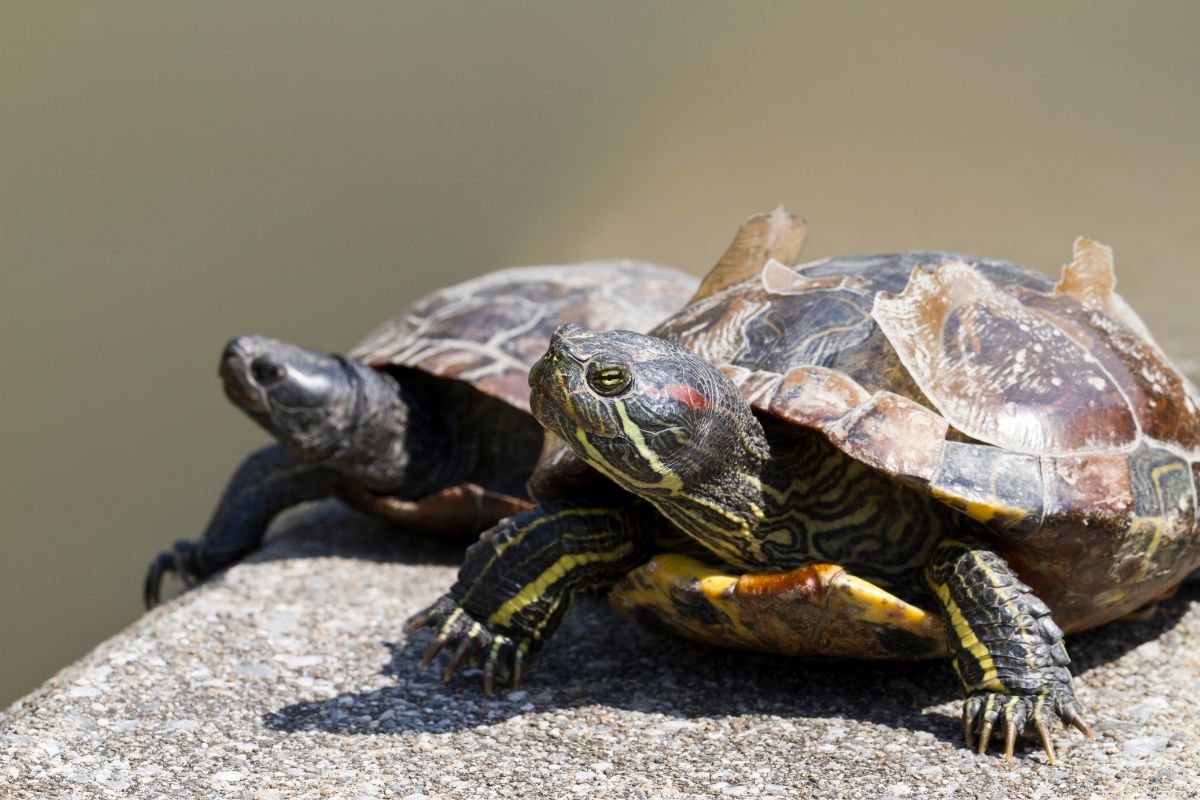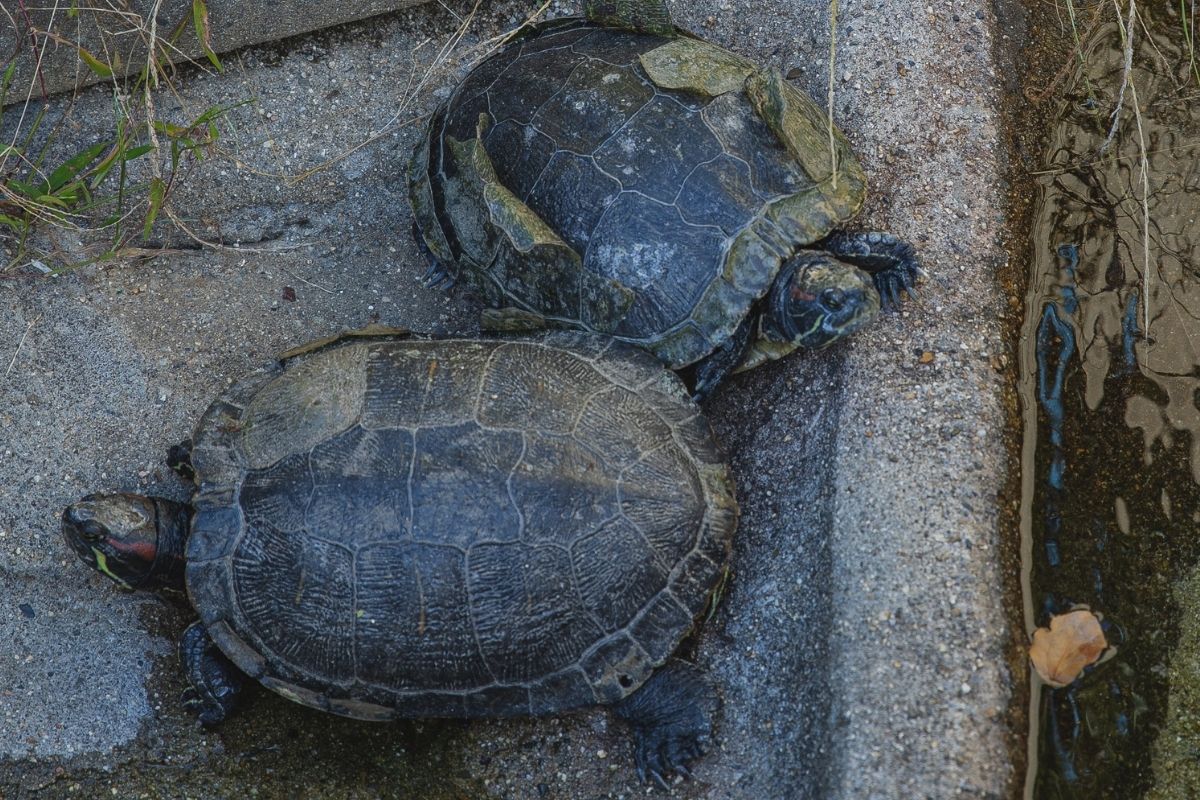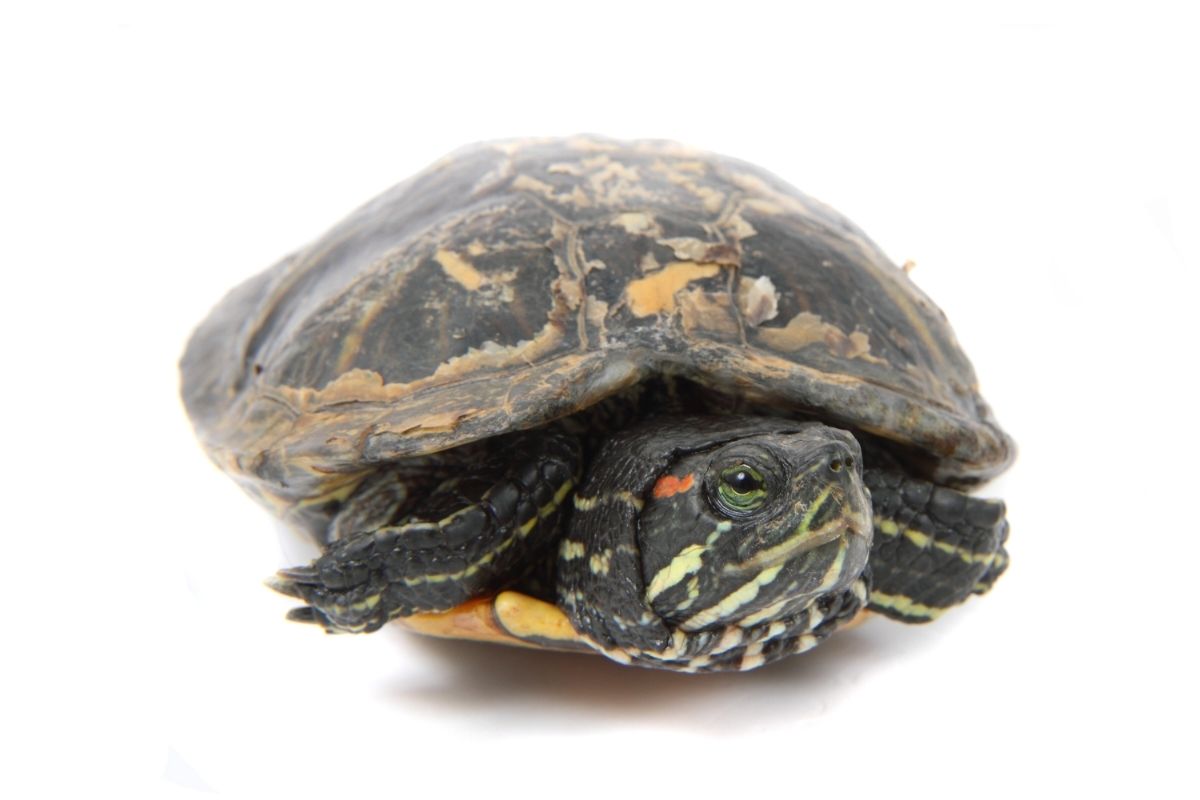Turtles are unique pets to have and can be absolutely fascinating to have around. You may have noticed that your turtle’s shell is peeling, but is this normal?

Thankfully, we can tell you that turtles peeling their shells is totally normal. Today we will teach you how to tell healthy shell peeling from unhealthy shell peeling, as well as what you should expect from turtle shell shedding, and more!
Most people don’t realize that turtles shed their shells every year. This is because they have a special layer of skin called the carapace that protects them from predators. The carapace also helps regulate body temperature
Shell Shedding – Is It A Real Thing?
Snakes shed their skin, and turtles peel their shells. It is not all that different, really.
Turtle shells are made up of many small bones, and they average around 60 bones per shell.
These are then covered by ‘plates,’ or what looks like ‘plates.’ However, these are actually named ‘scutes’. Scutes are made up of keratin, which is the same substance that makes up our hair and nails.
As the turtle ages, the scutes will fall off, and this is what we are talking about today. It is known as shedding the shell.
Most of the time, when a turtle sheds its shell, it is just part of their totally normal natural process. However, this can also be down to illness or in some cases, poor care of the turtle.
Why Might A Turtle’s Shell Peel?
A turtle’s shell can peel for natural reasons, such as growing. However, it can also peel in attempts to fight off infections, sickness, or something as bad as shell rot.
Some turtles shed their shells each year. A few species do not. However, most turtles will shed their shells after molting them. Molting is when an animal sheds its old skin so it has new skin underneath.
Molting can often happen when a female lays her eggs and then goes into hibernation for several months.
When she wakes up, she digs herself out of the nest and begins to molt. She sheds all the old skin and grows new skin underneath.
Do remember, this is not true for every species, but is for some.
Also, since their shell is made from bones covered by scutes, as they grow larger, their shell needs to accommodate their new size. So, shell shedding will be common in your turtles if you get them while they are young.
Reasons For Peeling
As turtle bones grow, their scutes will fall off to create room for their new and large scutes. However, this is the traditional reason this will happen.
Turtles will often bask in the sun to dry out their shell and skin and raise their temperature, as you will likely know if you own turtles.
However, if their shell is covered in something like algae, or if something is blocking them, then this can create issues with their internal temperature, which will make them slow, and their health will then be at risk!
Adding calcium enhancers to your turtle tank can aid in their shell health if you are concerned.
As a turtle sheds their scutes, it will aid in keeping it clean and free of blockages and potential infections.
They will also peel their shell if they are injured or if their shell is damaged. Perhaps if a shell is lost or damaged somehow, shedding allows them to regenerate this scute.
Turtles will also shed their shells to aid in the healing process.
What About Their Skin?
Turtles have rubbery and hardy tough skin. However, much like their shells, this skin cannot accommodate their growth as they age. For this reason, turtles also shed their skin to aid in their growth.
Turtle owners may also think that their turtle’s skin is shedding when in fact, the turtle’s skin is actually just extremely dry. It is important to know the difference.
Shell Peeling: Frequency And Breeds

Typically, you will find that aquatic turtles peel more than other species of turtle do. This is simply because infections and shell rot are more likely to happen in the water.
Thus, aquatic turtles who spend most of their time in the water are at high risk of these issues.
This makes aquatic turtles that peel their shell animals who simply use this as a defense mechanism against potential infections and parasites.
However, you will find that other breeds of turtle, like box turtles, rarely shed their shells. Yet, when box turtles shed, it is often part of a larger healing process.
So, if you were to ask how often shell shedding occurs, the main thing you need to consider is species.
Yet, there are often two primary periods in which you will find that turtles do shed. We mentioned this previously. Can you guess it?
Hibernation.
Turtles will shed their shells prior to hibernating and after hibernating.
A turtle will usually shed their shell before they hibernate. It prepares them for the only time dormant ahead.
This being said, turtles may usually shed much more after hibernation than they do before hibernation. Many call the period after hibernation the ‘frizzles.’ Maybe because they ‘frizzle’ their shells?
Top Shell Peeling Reasons
This is the main reason for shell peeling/shedding. However, there are other things as well that will lead to shell shedding in turtles. Let’s look over some of these alternative reasons.
- A turtle may shed their shell due to a fungal infection.
- Turtles might also shed their shells due to high ammonia levels in the water. Note that you need to have a good high-quality filter with a biofilter to counter this issue.
- They may shed if the basking area is too hot. Getting a thermometer to monitor this is wise.
- If your turtle is overfed and thus is growing too quickly. This is common in turtles whose owners feed them an inappropriate diet of too many and only protein pellets.
- It is also possible that a turtle may shed their shell due to a disease.
What If Their Scutes Aren’t Shedding?
Turtles can be picky creatures, and they may not shed their shells if the water or basking temperature is not ideal.
Remember that turtles have an ideal temperature, and if their water and basking areas are not on point, their biology can be disrupted.
It is also possible that they are not getting enough calcium to shed their shell. If your UV lightbulb is just fine and the temperature is okay, review the turtle’s diet.
Let’s consider these possibilities in more depth.
Is The Water Or Basking Temperature Right?
You should always check the ideal water and basking temperatures for your species of turtle and adjust it accordingly.
For a majority of domestic turtle species, the best temperature will be in the 70-80s for the water and 90s for the basking zone. Get a thermometer to check.
Is The UV Bulb Working As It Should?
It is not new news that UV bulbs will decrease in their quality as they get old. It is ideal for you to change your UV bulbs every 6 months or so.
A low-quality UV bulb can actually be damaging to your turtles’ health. So, keep on top of it.
Is Your Turtle Ingesting The Right Amount Of Calcium?
If your turtle does not get enough calcium in their diet, they will not be able to grow. So, you should double-check their diet and make sure that they are getting enough. If they are not, introduce calcium blocks to lend a hand.
NOTE: Your turtle may be shedding their shell, but they may be eating the shredded scute as soon as it peels off. Otherwise, you may not be able to see them in their aquarium, especially if you have a substrate or a rock bottom.
So, before you go tempering with your turtle’s environment or diet, make sure they are not shedding. Older turtles are less conspicuous with their shell shedding.
Things To Be On The Lookout For!

Shell shedding in turtles is a very natural occurrence. But remember that not every time a turtle sheds its shell for these natural means. Sometimes, when a turtle sheds, it can be for unpleasant reasons, such as parasites or disease.
A good way to tell if the shell shedding is natural and normal, you will find that the scutes will just fall away. Normally, they will be whole, and this will happen all over the shell, not just at the top.
You will notice the edges and bottom also peel off too!
If you notice scutes coming off at the bottom and sides, then this is a natural shedding, and you should feel at ease. Portions of the shell may seem to almost lift from the shell. This is fine, but do not try to pull them off.
These will come off naturally. A scute is ready to come off when it is easily pulled away. If there is any resistance to it coming off, then it is not ready, and you should leave it be.
Yet, if you believe that the shell of your turtle is blocked, such as with something like algae, you can attempt to cut it off with a knife. But be gentle.
This being said, it is just best to wait it out and see what happens. Using a knife can be dangerous.
Healthy Peeling: What It Looks Like
So, the final thing to say… How on earth do you tell if it’s healthy or unhealthy peeling?
Well, the best way you can tell if your turtle’s shell shedding is healthy or unhealthy is to inspect what the scutes look like once they are off.
A scute should be whole and totally intact once it has fallen off. Scutes should not come off in bits; if they do, this is a sign that your turtle is injured or sick.
Be aware that rocks that are sharp can often make a turtle’s scutes fall off prematurely, or they may also damage the scutes.
If this is the reason, ensure that your turtle’s environment is good for them, removing any potentially harmful items.
Another surefire way to ensure that the scutes are peeling normally is to inspect the scutes.
Note that scutes should not be thick, and they should actually be semi-see-through. Basically, they should look like a carbon copy of what they just came off of.
Also, do not forget that your turtle might try to eat some of its scutes once they fall off. They may break off a whole piece and just eat it. This is normal; it is safe and natural in many reptiles.
Just make sure that there are no random scutes lying around; they could injure your turtle if they try to eat them.
Frequently Asked Questions
Is It Normal For A Turtle To Shed Its Skin?
Water-based turtles will shed their shells (scutes) normally, it is simply a part of their natural biology. While a cat will shed their fur, our skin flakes off as dust, and a snake sheds its scales; turtles shed their shells too.
Do Any Turtles Shed Their Shells?
Most turtles do shed their shells, but not all. Always check to see if your turtles breed and shed their shells.
How Do You Tell If A Turtle Is Stressed?
A stressed turtle will be lethargic and may not eat much. Poor quality of water, diet, low temperatures, loud noises, and excessive handling can all be causes of stress.
